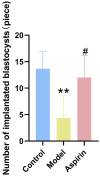Exploring the mechanism of action of aspirin in improving endometrial receptivity in PCOS rats based on uterine lavage fluid metabolomics
- PMID: 40403007
- PMCID: PMC12097608
- DOI: 10.1371/journal.pone.0324432
Exploring the mechanism of action of aspirin in improving endometrial receptivity in PCOS rats based on uterine lavage fluid metabolomics
Abstract
Backgrounds: Aspirin has been shown to enhance endometrial receptivity (ER) during the window of implantation in patients with polycystic ovary syndrome (PCOS). However, the underlying mechanisms remain unclear. This study aimed to elucidate the mechanisms by which aspirin improves ER through metabolic analysis of uterine lavage fluid.
Methods: A PCOS rat model was established using letrozole. Body weight and estrous cycles were monitored, and the number of implanted embryos was assessed across groups. We evaluated endometrial ultrastructure, ovarian and endometrial histomorphometry. Serum levels of estradiol(E2) and progesterone(P)were measured. Moreover, through ultra-performance liquid chromatography-mass spectrometry, the study of uterine lavage fluid metabolites revealed the potential mechanism of action of aspirin.
Results: Compared with the model group, aspirin treatment significantly increased embryo implantation rates, improved endometrial morphology and hormone levels. Metabolomic analysis identified 48 differential metabolites, among which five-2, 6-dihydroxypurine, gluconolactone, Oxaceprol, PC (18:1/18:1), and PC (20:3e/17:1)-were identified as potential biomarkers for aspirin-mediated improvement of ER in PCOS rats. Pathway analysis revealed that aspirin primarily modulates the pentose phosphate pathway, arginine and proline metabolism, and glycerophospholipid metabolism.
Conclusions: Aspirin may enhance glucose metabolism, alleviate insulin resistance, promote angiogenesis, and improve vascular permeability and endometrial receptivity. These effects are likely mediated through the regulation of biomarkers involved in the pentose phosphate pathway, arginine and proline metabolism, and glycerophospholipid pathways in uterine lavage fluid.
Copyright: © 2025 Zhang et al. This is an open access article distributed under the terms of the Creative Commons Attribution License, which permits unrestricted use, distribution, and reproduction in any medium, provided the original author and source are credited.
Conflict of interest statement
The authors have declared that no competing interests exist.
Figures









Similar articles
-
Effect of irisin on endometrial receptivity of rats with polycystic ovary syndrome.Gynecol Endocrinol. 2019 May;35(5):395-400. doi: 10.1080/09513590.2018.1529158. Epub 2019 Jan 9. Gynecol Endocrinol. 2019. PMID: 30626233
-
Nicotinamide Mononucleotide Improves Endometrial Homeostasis in a Rat Model of Polycystic Ovary Syndrome by Decreasing Insulin Resistance and Regulating the Glylytic Pathway.Mol Nutr Food Res. 2024 Nov;68(21):e2400340. doi: 10.1002/mnfr.202400340. Epub 2024 Oct 17. Mol Nutr Food Res. 2024. PMID: 39420767
-
Increased uterine androgen receptor protein abundance results in implantation and mitochondrial defects in pregnant rats with hyperandrogenism and insulin resistance.J Mol Med (Berl). 2021 Oct;99(10):1427-1446. doi: 10.1007/s00109-021-02104-z. Epub 2021 Jun 28. J Mol Med (Berl). 2021. PMID: 34180022 Free PMC article.
-
Uterine Function: From Normal to Polycystic Ovarian Syndrome Alterations.Curr Med Chem. 2018;25(15):1792-1804. doi: 10.2174/0929867325666171205144119. Curr Med Chem. 2018. PMID: 29210631 Review.
-
Therapeutic Potentials of Low-Dose Tacrolimus for Aberrant Endometrial Features in Polycystic Ovary Syndrome.Int J Mol Sci. 2021 Mar 12;22(6):2872. doi: 10.3390/ijms22062872. Int J Mol Sci. 2021. PMID: 33808965 Free PMC article. Review.
References
MeSH terms
Substances
LinkOut - more resources
Full Text Sources
Medical

